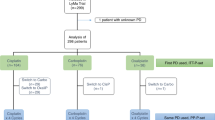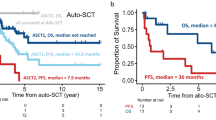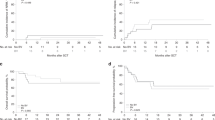Abstract
From 1991 to 1997 18 consecutive patients with well-defined mantle cell lymphoma (MCL) underwent high-dose therapy with unpurged autologous (17 patients) or allogeneic (one patient) stem cell transplantation. Tissue sections were reviewed for morphology, immunophenotype, cyclin D1 and P53 expression as well as proliferation index (PI). Median age of patients was 47 years (range 40–60). Sixteen had stage IV disease with bone marrow involvement in 12 and performance status was ⩾1 in 12 patients. At the time of high-dose therapy 10 patients were in first partial response (PR), one was in second complete remission (CR), four were in second PR and three were refractory to conventional anthracycline-containing chemotherapy. The conditioning regimen consisted of TBI plus chemotherapy in 13 patients and chemotherapy only (BEAM) in five patients. No treatment-related deaths were observed. With a median follow-up of 36 months (range 13–80) after transplant, disease-free survival (DFS) and overall survival (OS) are estimated to be 48 and 80% at 4 years, respectively. Significantly better results are achieved for patients transplanted after a TBI containing regimen with a 4 year OS and DFS estimated at 89 and 71%, respectively compared to 60 and 0% respectively for patients who were conditioned without TBI (P = 0.07 for OS and P < 0.0001 for dfs). there is a trend towards better dfs when the transplant is performed in pr1 (4 year dfs: 80% with eight patients out of 10 in continuous cr 13 to 80 months, median 36 months after transplant) compared to more advanced stages (4 year dfs: 18% with only three patients out of eight in continuous cr 16, 17 and 58 months after transplant). blastic histology and p53 overexpression are also associated with a trend towards a worst prognosis.
This is a preview of subscription content, access via your institution
Access options
Subscribe to this journal
Receive 12 print issues and online access
$259.00 per year
only $21.58 per issue
Buy this article
- Purchase on Springer Link
- Instant access to full article PDF
Prices may be subject to local taxes which are calculated during checkout
Similar content being viewed by others
Author information
Authors and Affiliations
Rights and permissions
About this article
Cite this article
Milpied, N., Gaillard, F., Moreau, P. et al. High-dose therapy with stem cell transplantation for mantle cell lymphoma: results and prognostic factors, a single center experience. Bone Marrow Transplant 22, 645–650 (1998). https://doi.org/10.1038/sj.bmt.1701400
Received:
Accepted:
Published:
Issue Date:
DOI: https://doi.org/10.1038/sj.bmt.1701400
Keywords
This article is cited by
-
Mantle Cell Lymphoma: Which Patients Should We Transplant?
Current Hematologic Malignancy Reports (2019)
-
Paramount therapy for young and fit patients with mantle cell lymphoma: strategies for front-line therapy
Journal of Experimental & Clinical Cancer Research (2018)
-
How to manage mantle cell lymphoma
Leukemia (2014)
-
Reappraising the role of autologous transplantation for indolent B-cell lymphomas in the chemoimmunotherapy era: is it still relevant?
Bone Marrow Transplantation (2013)
-
Clinical practice guidelines for diagnosis, treatment, and follow-up of patients with mantle cell lymphoma. Recommendations from the GEL/TAMO Spanish Cooperative Group
Annals of Hematology (2013)



